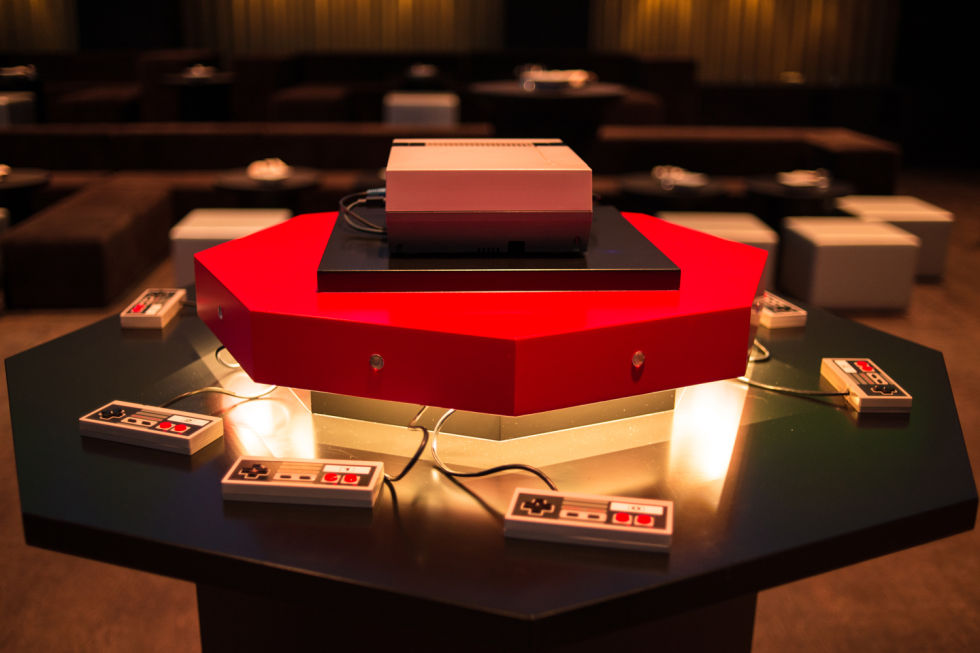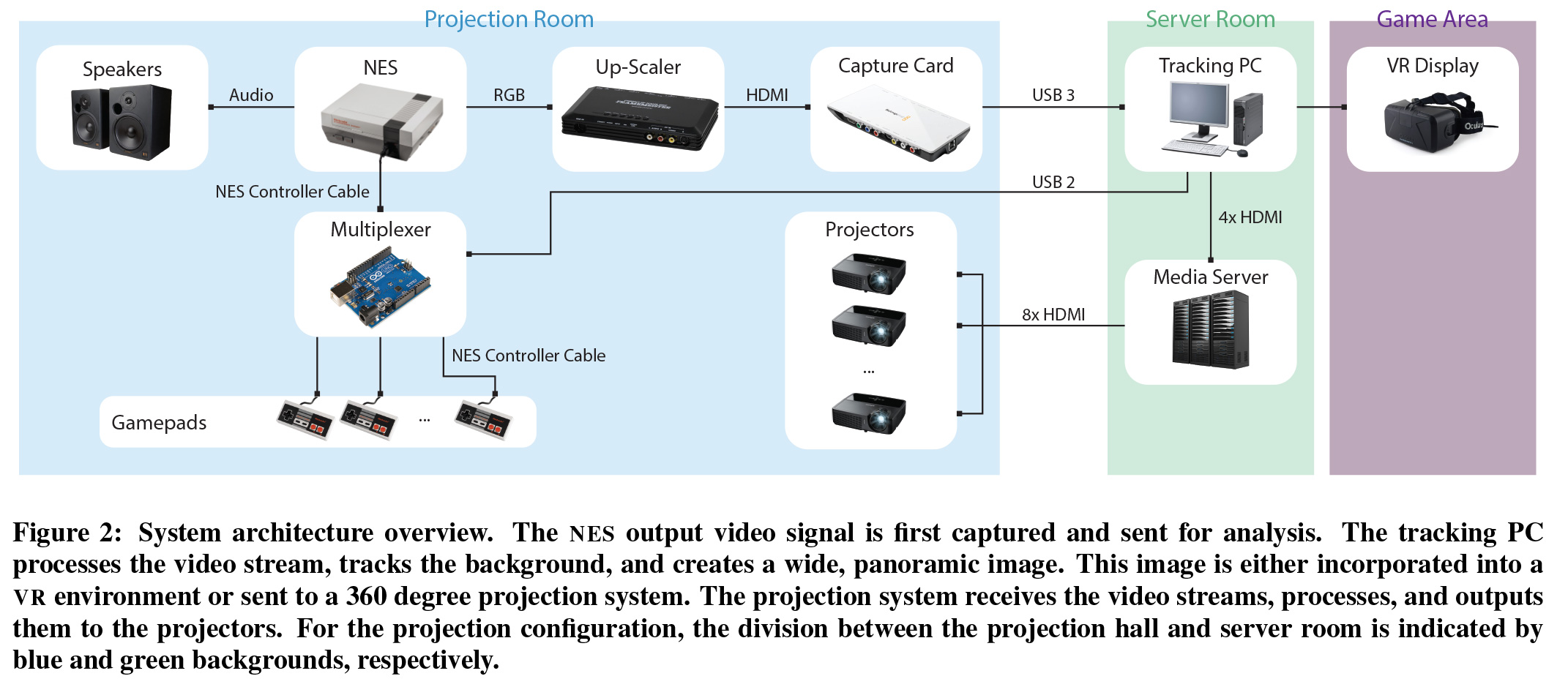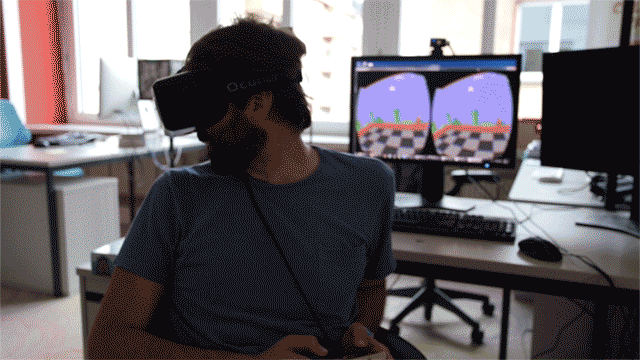8 bits, 8 players, 8 projectors and just one Nintendo Entertainment System
Turn NES into an 8-bit game console for an entire company
What will happen if we combine the boring ingenuity of the Swiss Higher Technical School of Zurich, the creative potential of Disney researchers and a chic Swiss night club with a 360-degree projection system? The world's only 8-bit Nintendo Entertainment System for sharing, for 8 players, offering continuous panoramic emulation, as you might guess, on a display with a 360-degree viewing angle.

So, you probably know that Super Mario is a side-scroller for one user from NES / Famicom. You are constantly moving forward, jumping over obstacles and jumping on the mushroom gumba until you pass the level. Well, that's all. There is no turning back, you cannot zoom out to see the part of the map left behind, and the maximum number of players is two: one for Mario and one for Luigi.
In May of this year, the Eurographics 2015 Conference was hosted by the Swiss Higher Technical School of Zurich together with the University of Zurich. Around the same time, Bob Sumner of Disney Research initiated the opening of the ETH Game Technology Center. Sumner was instructed to come up with “some cool concept” for dinner, scheduled for the end of the conference. So he and his fellow engineers did.
Back in July, when I met IBM’s Solar Sunflower, I met Sumner in Zurich. While we were sitting on the banks of the Limmat River, slowly sipping cold beer and complaining about price increases in his native cities, he talked about the main concept and goal of the project: “In general, it became clear that the era of 8-bit games played a huge role in the lives of many people , but, in fact, it all came down to the gaming experience of an individual. “We wanted to completely change the approach, so that the NES console would allow us to go up to the group level, so that users play together.”
How does NES turn into a 360-degree gaming machine?

A complete set of the system
But, as they say, let's take it in order: the development team used real NES with real game cartridges. The structure of the console remained untouched, as, in fact, gaming ROMs. Everything that you see in the photo and video was created using improvised hardware and software.
Eight controllers used an Arduino-based multiplexer to connect to NES. The video signal from NES is transmitted through the upscaler, which provides pleasant performance at 576p, 50Hz. The audio signal comes from the NES directly into the room's sound system.
Then, a higher resolution video is transmitted to the “control PC”. This computer has several user programs that accept incoming video frames and copy them to a new, more powerful buffer. The software analyzes the background of each incoming frame and tries to align it with the background of the previous one, connecting them together into a common panorama. It sounds simple enough until you think about that: a) the background can move very fast or very slow, depending on the player, and b) in most side scrollers, the player can walk in the opposite direction.
After the control PC completes this process, the video signal is transmitted to the media server, which in turn launches eight projectors (two for each wall). Since each wall has different proportions and the media server stretches the final image a bit to cover the required area, a “GPU algorithm” is provided on the control PC that corrects distortion in real time. As a result, as you might have guessed, we get a new high-quality version of Super Mario Bros, Castlevania and other classic NES games.
How can eight people play Super Mario Bros?

A few examples of stitched panoramas
As a final part of the equation, it remains to turn the original NES game for one or two players into an option for sharing for 8 people. The Arduino multiplexer has two operating modes: is it either a cycle for each gamepad after a certain period of time; or the host PC can switch the Arduino to a specific gamepad, depending on the progress of the players within the same level.
So, for example, Super Mario Bros will start switching between gamepads every five seconds or every time when Mario will walk a certain distance relative to the end of the level. In the case of eight players whose zones form an octagon, you can configure the system so that each player controls Mario when the character enters the corresponding section of the wall.
As a result, according to Sumner, the product was incredibly fun, albeit with a touch of insanity. Due to the constant “interception of the initiative” it is very difficult to carry out certain actions qualitatively. For example, it is not easy to use the super sheet in Super Mario Bros 3, which allows Mario to fly, because sometimes, to take off, the coordinated work of three players in a row is required. Or, you are about to jump to the gumba to destroy the mushroom, and suddenly after a legal five seconds you lose control.
What if you do not have eight projectors?
When Bob finished the story about how their crazy project worked, turning the NES concept upside down, the first thing I wanted to do was, of course, to try it out. Unfortunately, Bob no longer had access to the projection system at 360 degrees, as well as the time to spend the whole day connecting the necessary equipment.
But this does not mean that I am left with nothing. At the Disney Research offices (which, incidentally, are just wonderful), the team whipped up an alternative output system: Oculus Rift. She looked a little strange and there was no regime for eight players, but the essence of this did not change. In principle, as you move up the level, the control computer continually draws a panorama that unfolds - you can turn your head and the viewing angle will change.

The main problem is that I turned my head with all my might until the kinematics of my mortal spine reminded me of possible paralysis. Then I had to quickly turn my head in the other direction, and then it was possible to continue the game in the usual mode. It turned out a little tiring, but still a lot of fun.
To familiarize the public with the technical details of the project, the Swiss Higher Technical School of Zurich published in open access a scientific article entitled "The Beginning of the 8-Bit Era." Last week, a document was presented in London at the Visual Media Conference. The project was led by Sumner, who worked with a team of graduate students at the Swiss Higher Technical School and Disney Research.
Source: arstechnica
